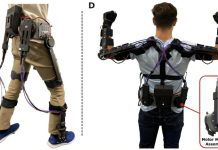
Scientists have teamed up to create a groundbreaking material that can make sound waves get stronger as they move through it.
This new discovery could make devices like sensors and computers work better than ever before.
The material is based on a super-smart design called a “bosonic Kitaev chain.”
It’s a bit like a futuristic chain where each link is a tiny, vibrating string that can interact with light to behave in a special way.
This concept was inspired by a theory about how electrons move in a certain kind of wire, but here it’s all about sound or light waves.
To make this idea a reality, the researchers used something called “optical springs.” Imagine normal springs, but instead of metal, they’re made of light!
By adjusting the light’s strength, the scientists could connect these tiny strings in just the right way.
When they tested it out, they found that the sound waves didn’t just move through the material—they got louder and louder as they went.
Even cooler, the sound waves only got louder in one direction. If the waves were tweaked a little, they could even switch directions, getting louder the other way. It’s like a one-way street for sound that can suddenly flip direction!
This clever design is called a topological metamaterial because of how it’s built and how it behaves.
It’s super reliable too; even if the material isn’t perfect, it still works. Plus, it’s extra sensitive to certain changes, which could make it awesome for detecting tiny things like molecules or for improving quantum technology.
The big brains behind this invention think it’s just the start. They believe this new material could lead to sensors that are better at picking up signals, even among distractions. It’s an exciting step forward, blending physics, engineering, and a dash of imagination to open up new possibilities for technology.



